The next time you are in Washington D.C. be sure to take an hour (or two) and tour the Congressional Cemetery located at 1810 E Street SE. You will find it by driving east on Independence Avenue SE and turning south on 18th Street. Or the quickest way to get there is to take either the Orange or Blue Metro Train and get off at the Stadium-Armory Station and walk four blocks south to the entrance gate. Cemetery tours are also available on the internet by logging onto www.congressionalcemetery.org.
It was the establishment of the District of Columbus in 1790 as the center for our new nation that brought prominent citizens from across the country to the banks of the Potomac River. Along with the presidents and congressmen came builders, military leaders and merchants to build the new government and its new capital. A suitable burying space within reasonable proximity of this community was needed. This brought about the Washington Parish Burial Ground, established by private citizens in 1807. By 1820 it was known as the “national burying ground” due to the many grand funeral processions for prominent architects and builders, musicians and explorers, patriots and scoundrels, pioneers and diplomats, and veterans of every war. There are both guided and self-guided walking tours which will take you to the grave sites of J. Edgar Hoover (1895-1972), John Philip Sousa (1854-1932), Mathew Brady (1822-1896), and Elbridge Gerry (1744-1814). The last name you may not recognize, but history tells us that, when Mr. Gerry was governor of Massachusetts, he signed a bill that redistricted several major districts which were shaped like salamanders. Thus bringing “Gerrymander” into the political lexicon.
The Congressional Cemetery is home to 165 “cenotaphs,” which honor members of Congress who died in office during the first several decades of the nation’s history. The term cenotaph refers to any empty tomb. The only cenotaph for a nonmember of Congress belongs to William Thornton (1757-1826) who in 1792 won the competition for the design of the U.S. Capitol and the White House. His prize was $500 and a city lot. The last Congressman to have a cenotaph was “Tip” O’Neill (1912-1994).

My tour guide had some interesting facts to point out about the cemetery. He explained that stone masons working on the Capitol Building would come to the cemetery on their time off and carve tombstones which today are some of our country’s first works of art. He also pointed out tombstones in the old section that were designed as tables. Visiting family members of the deceased would spread picnic lunches on top of the tables as the trip and visit to the cemetery were usually an all day event from downtown Washington. The guide also said that this cemetery predates the Arlington Cemetery by 70 years, that it grew from 4.5 to 32.5 acres, that it holds 55,000 individuals and that it contains 14,000 tombstones. (Poland’s Riverside Cemetery is the same size with fewer tombstones and individuals buried there.)
I paid my respects to Ruth Ann Overbeck, historian for the cemetery and the person who was instrumental in preserving the surrounding neighborhood’s history. She died of cancer recently and her tombstone contains only the words “Look it up,” suggesting that anyone interested in the dates of her birth and death would have to look it up. Not too distance from Overbeck’s grave is that of Flora Adams Darling (1840-1910). She was the founder of the Daughters of the American Revolution and the U.S. Daughters of 1812.

The Public Vault
Of particular interest to historians is the Public Vault built by Congress to hold the remains of prominent political persons until proper arrangements were made for transportation
of the bodies to their final resting place. The vault was constructed long before embalming was available. Dolly Madison was placed in the vault upon her death in 1849 but because her son had bankrupted the family, she remained there for five years. The vault also held the remains of President John Quincy Adams, William Henry Harrison and Zachary Taylor. The Public Vault is empty at the present time.
